Spanish Oak
Quercus falcata
Beech family (Fagaceae)
Quercus falcata
Beech family (Fagaceae)
Description:
This single-trunked tree is about 60–80' tall at maturity (rarely
taller). The crown is more narrowly rounded with ascending branches
under
forest conditions, but it becomes more broadly rounded in open
conditions.
The trunk is 2–3¼' across and straight. On mature trees, trunk bark is
dark gray with flat ridges and narrow brownish furrows, while on
younger trees it is more smooth. Large to medium small branches have
medium gray bark that is relatively smooth, while twigs are
orange-brown, angular, and glabrous to short-pubescent (usually the
latter). Young shoots are light green and short-pubescent. Alternate
leaves occur along the shoots and twigs. Individual leaves are 4–8"
long and 2½–4½" across; they have 3–5 (rarely 7) major lobes and a few
teeth that terminate into short exserted veins. The major lateral lobes
curve toward the tip of each leaf; they taper gradually into acute
tips. The terminal lobe of each leaf is usually long and slender, while
the base of each leaf is either narrowly U-shaped or narrowly
wedge-shaped. The upper leaf surface is medium to dark green, hairless,
and shiny, while the lower leaf surface is short-pubescent with either
grayish white or light brown stellate hairs.
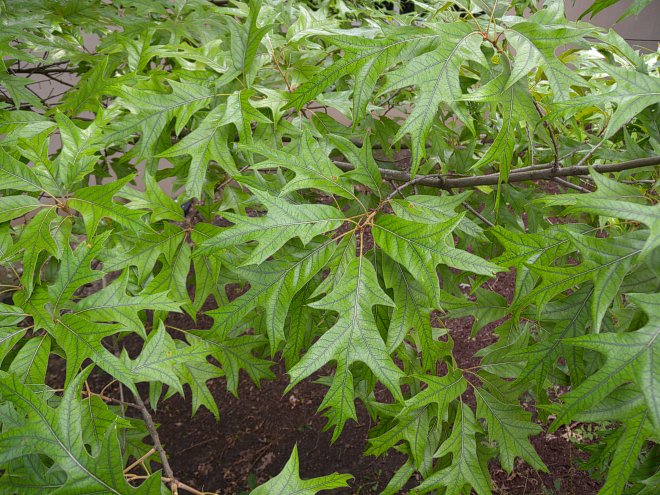
Like other oaks, this oak is monoecious, producing staminate (male) florets and pistillate (female) florets on the same tree. The staminate florets develop on drooping catkins about 3–6" long that are yellowish green. Each staminate floret has several stamens. The tiny pistillate florets are either solitary or in clusters of 2-3; they develop in the axils of leaves. Each pistillate floret is surrounded by opaque membranous bracts that are brownish and hairy, forming an ovoid shape; its stigmas are purple. Cross-pollination of the florets is by wind during mid- to late spring. Afterwards, the staminate catkins fall to the ground, while the pistillate florets slowly develop into acorns. Acorns become mature during autumn after 2 years.
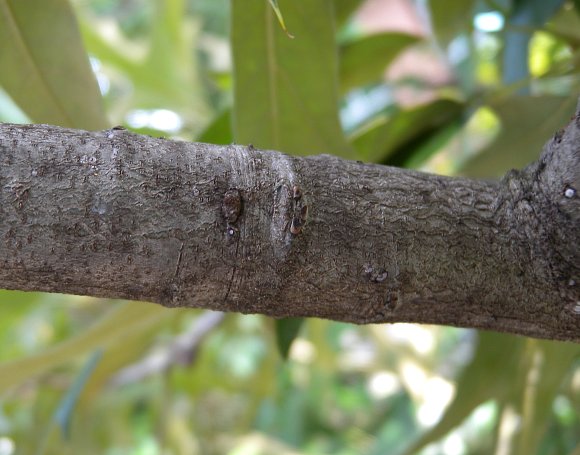
Each mature acorn is about ½" long and similarly across, consisting of a shallow cap and the body of a nut. The cap of the acorn is covered with flat light brown scales that are lanceolate in shape with blunt tips, while the surface of the body is light orange-brown. The root system initially consists of a taproot, which eventually dies back when it is replaced by deep lateral roots. This tree reproduces by reseeding itself.
Cultivation: The preference is partial to full sun, mesic to dry conditions, and a somewhat acidic soil containing loam, clay, rocky material, or sand. This tree is winter-hardy into Zone 5 for specimens of more northern provenance. It starts producing acorns after 25 years and it can live for 100-150 years.
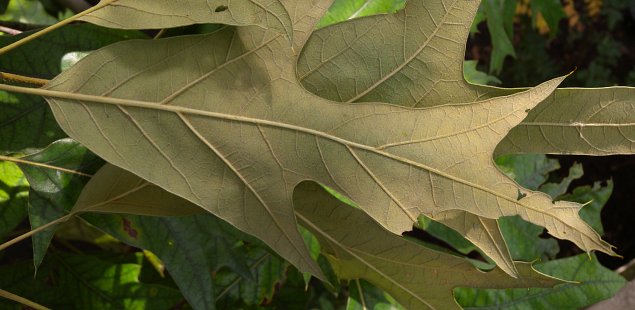
Range & Habitat: Spanish Oak (Quercus falcata) is native to southern Illinois, where it is occasional (see Distribution Map). Elsewhere within the state, it does not occur, except as an uncommon cultivated tree. Illinois is located along the northern range-limit of this tree; it is found in most areas of southeastern United States. Habitats include upland woodlands, upland savannas, wooded slopes, flatwoods, and bluffs. The dominant trees in these habitats are either oaks or a mixture of oaks and pines. Spanish Oak is more vulnerable than the majority of other oaks to wildfires, even though wildfires help to create the open habitats where this tree thrives.

Faunal Associations: Oak trees (Quercus spp.) are very important in providing food and protective cover for many species of insects, birds, and mammals. Insects that feed on Spanish Oak (Quercus falcata) include larvae of the Basswood Leafminer (Baliosus nervosus), acorn-infesting larvae of weevils (Curculio spp.), leafhoppers (Eratoneura spp.), and bark-infesting scale insects (Diaspidiotus osborni, Melanaspis obscura); see Eiseman (2016), Gibson (1985), Dmitriev & Dietrich (website, accessed 2010), and ScaleNet (website, accessed 2014). Other insects that feed on oaks include the larvae of metallic wood-boring beetles (Chrysobothris spp.), larvae of metallic leaf-miner beetles (Brachys spp.), wood-boring larvae of long-horned beetles (Enaphalodes spp., Goes spp.), larvae and adults of leaf beetles (Metachroma spp.), larvae of gall flies (Macrodiplosis spp.), aphids (Myzocallis spp., Stegophylla spp.), treehoppers (Cyrtolobus spp., Telamona spp.), larvae of sawflies (Caliroa spp., Periclista spp.), larvae of miscellaneous tiger moths (Arctiidae), larvae of miscellaneous Geometer moths (Geometridae), larvae of leaf-blotch miner moths (Cameraria spp., Phyllonorycter spp.), larvae of skippers (Erynnis spp.), larvae of slug caterpillar moths (Limacodidae), larvae of hairstreak butterflies (Satyrium spp.), larvae of miscellaneous midget moths (Nepticulidae), larvae of owlet moths (Acronicta spp., Catocala spp.), larvae of miscellaneous prominent moths (Notodontidae), larvae of oakworm moths (Anisota spp.), larvae of trumpet leaf-miner moths (Tischeria spp.), larvae of miscellaneous tortrix moths (Tortricidae), nymphs and adults of walkingsticks (Phasmatodea), and various stink bugs (Pentatomidae).
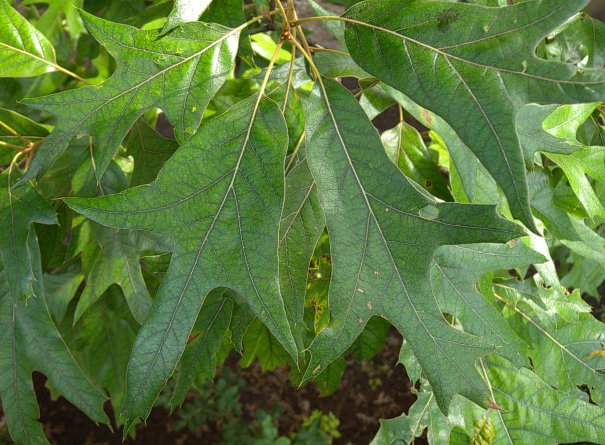
The acorns of Spanish Oak are an important source of food for birds because of their small size. Birds that eat these acorns include the Blue Jay, American Crow, Tufted Titmouse, Wild Turkey, Red-bellied Woodpecker, Red-headed Woodpecker, White-breasted Nuthatch, and Carolina Parakeet (now extinct). Mammals that eat the acorns include the American Black Bear, Raccoon, Southern Flying Squirrel, Eastern Gray Squirrel, Fox Squirrel, Eastern Chipmunk, and White-footed Mouse. Hawks and owls often use oaks as roosting sites and nest sites. Various bats also use oaks as summer roost sites, summer maternity colonies, and winter dens (inside tree hollows).
Photographic Location: The photographed tree was cultivated near a hospital in Urbana, Illinois, where it displayed symptoms of iron chlorosis.
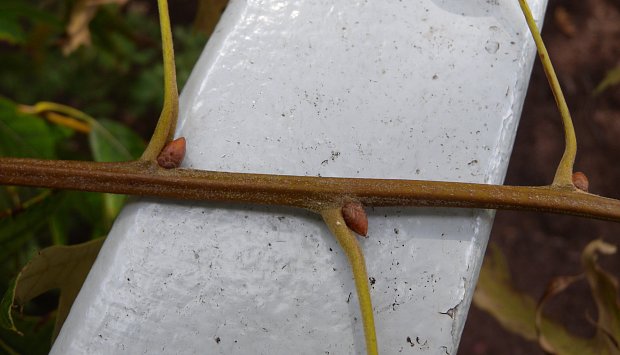
Comments: Spanish Oak (Quercus falcata) is a more southern oak that prefers somewhat acidic locations with poor soil. It is also referred to as Southern Red Oak. At one time, Spanish Oak was regarded as a variant of the Cherrybark Oak (Quercus pagodifolia), but it now considered a distinct species. The wood of this oak strong, heavy, rough-textured, and coarsely grained; it is vulnerable to warping while drying. The wood has been used primarily for industrial purposes, such as factory lumber, rail ties, and fence posts; it is also useful as firewood. Spanish Oak can be distinguished from other oaks by the small size of its acorns (making them suitable for birds as a source of food) and by the characteristics of its leaves. The leaves of Spanish Oak can be distinguished from the leaves of other oaks by their fewer lobes (typically only 3 or 5), long slender terminal lobe, and narrow rounded base. The lower sides of Spanish Oak's leaves are short-pubescent throughout with either grayish white hairs or light brown hairs.

Like other oaks, this oak is monoecious, producing staminate (male) florets and pistillate (female) florets on the same tree. The staminate florets develop on drooping catkins about 3–6" long that are yellowish green. Each staminate floret has several stamens. The tiny pistillate florets are either solitary or in clusters of 2-3; they develop in the axils of leaves. Each pistillate floret is surrounded by opaque membranous bracts that are brownish and hairy, forming an ovoid shape; its stigmas are purple. Cross-pollination of the florets is by wind during mid- to late spring. Afterwards, the staminate catkins fall to the ground, while the pistillate florets slowly develop into acorns. Acorns become mature during autumn after 2 years.

Each mature acorn is about ½" long and similarly across, consisting of a shallow cap and the body of a nut. The cap of the acorn is covered with flat light brown scales that are lanceolate in shape with blunt tips, while the surface of the body is light orange-brown. The root system initially consists of a taproot, which eventually dies back when it is replaced by deep lateral roots. This tree reproduces by reseeding itself.
Cultivation: The preference is partial to full sun, mesic to dry conditions, and a somewhat acidic soil containing loam, clay, rocky material, or sand. This tree is winter-hardy into Zone 5 for specimens of more northern provenance. It starts producing acorns after 25 years and it can live for 100-150 years.

Range & Habitat: Spanish Oak (Quercus falcata) is native to southern Illinois, where it is occasional (see Distribution Map). Elsewhere within the state, it does not occur, except as an uncommon cultivated tree. Illinois is located along the northern range-limit of this tree; it is found in most areas of southeastern United States. Habitats include upland woodlands, upland savannas, wooded slopes, flatwoods, and bluffs. The dominant trees in these habitats are either oaks or a mixture of oaks and pines. Spanish Oak is more vulnerable than the majority of other oaks to wildfires, even though wildfires help to create the open habitats where this tree thrives.

Faunal Associations: Oak trees (Quercus spp.) are very important in providing food and protective cover for many species of insects, birds, and mammals. Insects that feed on Spanish Oak (Quercus falcata) include larvae of the Basswood Leafminer (Baliosus nervosus), acorn-infesting larvae of weevils (Curculio spp.), leafhoppers (Eratoneura spp.), and bark-infesting scale insects (Diaspidiotus osborni, Melanaspis obscura); see Eiseman (2016), Gibson (1985), Dmitriev & Dietrich (website, accessed 2010), and ScaleNet (website, accessed 2014). Other insects that feed on oaks include the larvae of metallic wood-boring beetles (Chrysobothris spp.), larvae of metallic leaf-miner beetles (Brachys spp.), wood-boring larvae of long-horned beetles (Enaphalodes spp., Goes spp.), larvae and adults of leaf beetles (Metachroma spp.), larvae of gall flies (Macrodiplosis spp.), aphids (Myzocallis spp., Stegophylla spp.), treehoppers (Cyrtolobus spp., Telamona spp.), larvae of sawflies (Caliroa spp., Periclista spp.), larvae of miscellaneous tiger moths (Arctiidae), larvae of miscellaneous Geometer moths (Geometridae), larvae of leaf-blotch miner moths (Cameraria spp., Phyllonorycter spp.), larvae of skippers (Erynnis spp.), larvae of slug caterpillar moths (Limacodidae), larvae of hairstreak butterflies (Satyrium spp.), larvae of miscellaneous midget moths (Nepticulidae), larvae of owlet moths (Acronicta spp., Catocala spp.), larvae of miscellaneous prominent moths (Notodontidae), larvae of oakworm moths (Anisota spp.), larvae of trumpet leaf-miner moths (Tischeria spp.), larvae of miscellaneous tortrix moths (Tortricidae), nymphs and adults of walkingsticks (Phasmatodea), and various stink bugs (Pentatomidae).

The acorns of Spanish Oak are an important source of food for birds because of their small size. Birds that eat these acorns include the Blue Jay, American Crow, Tufted Titmouse, Wild Turkey, Red-bellied Woodpecker, Red-headed Woodpecker, White-breasted Nuthatch, and Carolina Parakeet (now extinct). Mammals that eat the acorns include the American Black Bear, Raccoon, Southern Flying Squirrel, Eastern Gray Squirrel, Fox Squirrel, Eastern Chipmunk, and White-footed Mouse. Hawks and owls often use oaks as roosting sites and nest sites. Various bats also use oaks as summer roost sites, summer maternity colonies, and winter dens (inside tree hollows).
Photographic Location: The photographed tree was cultivated near a hospital in Urbana, Illinois, where it displayed symptoms of iron chlorosis.

Comments: Spanish Oak (Quercus falcata) is a more southern oak that prefers somewhat acidic locations with poor soil. It is also referred to as Southern Red Oak. At one time, Spanish Oak was regarded as a variant of the Cherrybark Oak (Quercus pagodifolia), but it now considered a distinct species. The wood of this oak strong, heavy, rough-textured, and coarsely grained; it is vulnerable to warping while drying. The wood has been used primarily for industrial purposes, such as factory lumber, rail ties, and fence posts; it is also useful as firewood. Spanish Oak can be distinguished from other oaks by the small size of its acorns (making them suitable for birds as a source of food) and by the characteristics of its leaves. The leaves of Spanish Oak can be distinguished from the leaves of other oaks by their fewer lobes (typically only 3 or 5), long slender terminal lobe, and narrow rounded base. The lower sides of Spanish Oak's leaves are short-pubescent throughout with either grayish white hairs or light brown hairs.